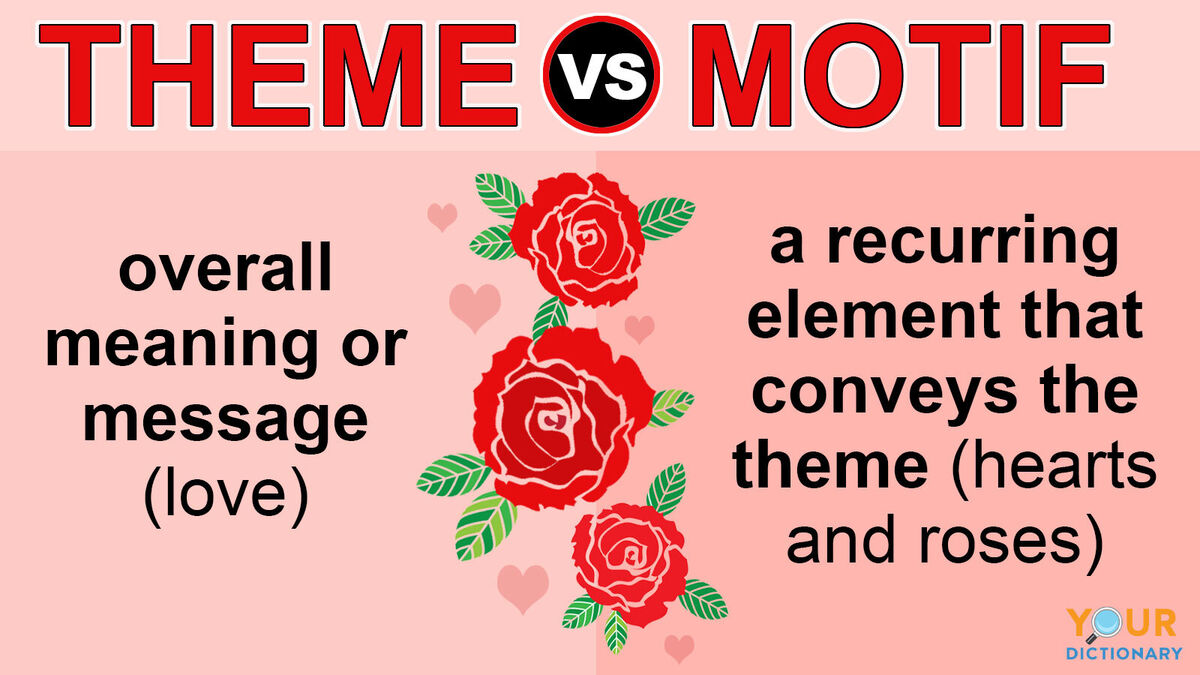
While theme and motif both provide insight into the overall message of a work of writing, the two terms are not identical. Explore theme vs. motif to clarify your understanding of these two related — but not identical — concepts.
What Is Theme?
Theme is a broad term that relates to the overall message or meaning of a literary work. Sometimes the author clearly articulates the theme, but not always. When the theme is not clearly stated, the author uses one or more literary devices to overtly convey the theme to readers.
What Is Motif?
A motif is a recurrent element within a work of literature that serves the purpose of developing or helping to reveal the theme. Motifs can appear in many forms, including ideas, images, sounds, symbols, and words.
All motifs have two things in common: (1) they are used multiple times in a work of literature and (2) their purpose is to convey the work’s theme.
Theme vs. Motif: List of Examples
Many books that students read in school have themes that are revealed, at least in part, through motifs. Review a few examples of motif vs. theme.
- Magic, of course, is a major theme of the Harry Potter series by J.K. Rowling. It is directly stated, but also reflected in many motifs. Examples include the broomsticks, Harry's cloak of invisibility and magic wands.
- Love is a key theme in Romeo and Juliet by William Shakespeare. Roses are a motif related to love throughout the play, as are the many conversations on love throughout the work.
- Interconnectedness is one of the themes in Great Expectations by Charles Dickinson. It is illustrated through the motif of double characters. For example, there are two benefactors, two convicts, two love interests for Pip, two elderly women, and others pairs.
- Protecting the innocent is a major theme of To Kill a Mockingbird by Harper Lee. This is reflected throughout the book by the repeated appearance of the mockingbird, an innocent creature that the children are cautioned not to hurt because it doesn't hurt anyone.
- Doing your civic duty and being committed to democracy are two key themes of 12 Angry Men by Reginald Rose. The repeated voting process the jury engages in is a motif that links to these themes.
- The thin line between savagery and civilization is a primary theme of Lord of the Flies by William Golding. This is reflected in motifs related to the boys (except Piggy) becoming savage, such as repeated references to their tangled hair and the conch shell used to call meetings to order that is eventually destroyed.
- The illusion of wealth is a key theme in The Great Gatsby by F. Scott Fitzgerald. It is revealed through several motifs, including the extravagance of Jay's lifestyle, the over-the-top parties and symbols of old money and new money throughout the book.
- Death is a pivotal theme in The Catcher in the Rye by J.D. Salinger. It is reflected in many motifs, including Holden's regular conversations with his deceased brother and recurring imagery of the gloomy cemetery and tombstones within in.
- Pursuing the American Dream is one of the key themes of The Grapes of Wrath by John Steinbeck. This motif is illustrated by the recurrence of the journey along Route 66 as the migrants travel along this path in search of a better life, as well as the grapes that symbolize the fruits of their labor at the journey's end.
There are many additional examples of motifs in works of writing. There are also many more examples of theme in literature.
How Does Motif Relate to Symbols?
Since motifs can be symbols, it’s not surprising that people sometimes think that motifs and symbols are the same things. Symbols sometimes function as motifs in a work of literature, but not always.
- If a particular symbol appears only one or two times in a work of literature, then it isn’t functioning as a motif, because it is not a recurrent element of the work.
- If a symbol does appear numerous times in a work and also conveys its overall theme, then it would be a motif. Otherwise, it’s just a symbol.
Importance of Motif
Motif is very important in writing, as is theme. Motifs help bring the theme to life in a very real way. Their repetitive nature helps reveal and reinforce the most important themes of a work of writing. They provide readers with a consistent context within which to interpret the work while adding depth to the overall story.
Enhance Your Literary Skills
Now that you know the difference between theme and motif, check out the difference between theme and topic. Continue learning more about literature by mastering some of the most commonly used literary devices. You'll be able to use your new knowledge to craft an insightful literary analysis essay.